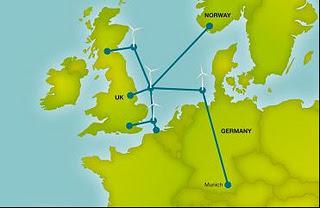The challenges facing the integration of wind power
To fully integrate wind power into the grid there needs to be a systematic upgrade of the existing infrastructure, as well as the introduction of new technology and network management techniques. Furthermore the development of offshore super grids may be the most effective way of sourcing renewable energy from wind power and distributing it efficiently.
Transmission capacity must be significantly increased to accept the introduction of wind power, and some of the measures that can be taken include utilizing existing transmission lines to their maximum capacity, investment in the construction of new transmission lines, and investment in other areas of the network and the upgrade of assets.
Existing lines can be maximised to their full potential by operating them at higher capacity, which would need to be supported by temperature monitoring to ensure network integrity. The cross border exchange of power between countries can also be streamlined and seen as a measure to ease congestion. Automatic generation control systems, or managed demand-side control systems may also be options to alleviate congestion and control the network, but these are seen as short term options as they are not efficient in terms of energy generation.
The most obvious form of network upgrade is the construction of new, high voltage power lines. In many cases this is unavoidable to connect offshore wind farms to the grid due to their location and the lack of existing transmission lines. One of the challenges facing TSO’s here is the fact that planning permissions for new lines often takes 10-12 years, much longer than the planning permissions for offshore wind farms. TSO’s are faced with making early decisions on the proposals of new lines to ensure they are in place in time for when a wind farm becomes operational. This presents a risk for the industry, as at the time of planning it cannot be assured that the construction of a particular wind farm will actually go ahead.
Investment in assets and other areas of the network is another possibility that will aid the integration of wind power and realise increased power supply and ease of exchange with other countries. This may include adding transformers to existing substations to increase load capacity, replacing line conductors with high temperature conductors or adding second circuit lines to towers, or replacing transmission lines with higher voltage lines and increasing capacity.
Increased transmission capacity is vital for the integration of wind power to the grid, but equally the EU has taken steps to ensure fair access for wind power. The ‘third liberalisation package’ stipulates that TSO’s ensure that there is sufficient transmission capacity to integrate renewable energy into the grid. While this can present a problem for TSO’s in terms of planning permissions in regard to constructing new lines to connect to wind farms, in the interim the problem is usually solved by ‘connecting and managing’ where grid capacity is limited.
The development of super grids
According to the organisation ‘Friends of the Super grid’, a super grid can be defined as, "An electricity transmission system, mainly based on direct current, designed to facilitate large-scale sustainable power generation in remote areas for transmission to centres of consumption, one of whose fundamental attributes will be the enhancement of the market in electricity".(5)
The development of an offshore super grid is becoming the most likely route towards harnessing renewable energy from wind power. The creation of ‘supernodes’ which will collect, integrate and distribute electricity will enable full integration in the long term future. The phase 1 example of the North Sea super grid proposed by the ‘Friends of the Super grid’ above, shows how the initial development may look. With the power generated by offshore wind estimated to be over 150MW by 2030 by the EWEA (European Wind Energy Association), a network connecting countries via the North Sea will enable supply and distribution to areas of demand, and ease cross-country distribution significantly.
Looking towards 2050 and a zero-carbon society, it is estimated that large wind fired power stations will be the building blocks of the super grid, with up to 500MW of capacity. This will enable the connection of several wind farms to one power station which can control the variable power output and integrate it fully via the network.
To fully integrate wind power into the grid there needs to be a systematic upgrade of the existing infrastructure, as well as the introduction of new technology and network management techniques. Furthermore the development of offshore super grids may be the most effective way of sourcing renewable energy from wind power and distributing it efficiently.
Transmission capacity must be significantly increased to accept the introduction of wind power, and some of the measures that can be taken include utilizing existing transmission lines to their maximum capacity, investment in the construction of new transmission lines, and investment in other areas of the network and the upgrade of assets.
Existing lines can be maximised to their full potential by operating them at higher capacity, which would need to be supported by temperature monitoring to ensure network integrity. The cross border exchange of power between countries can also be streamlined and seen as a measure to ease congestion. Automatic generation control systems, or managed demand-side control systems may also be options to alleviate congestion and control the network, but these are seen as short term options as they are not efficient in terms of energy generation.
The most obvious form of network upgrade is the construction of new, high voltage power lines. In many cases this is unavoidable to connect offshore wind farms to the grid due to their location and the lack of existing transmission lines. One of the challenges facing TSO’s here is the fact that planning permissions for new lines often takes 10-12 years, much longer than the planning permissions for offshore wind farms. TSO’s are faced with making early decisions on the proposals of new lines to ensure they are in place in time for when a wind farm becomes operational. This presents a risk for the industry, as at the time of planning it cannot be assured that the construction of a particular wind farm will actually go ahead.
Investment in assets and other areas of the network is another possibility that will aid the integration of wind power and realise increased power supply and ease of exchange with other countries. This may include adding transformers to existing substations to increase load capacity, replacing line conductors with high temperature conductors or adding second circuit lines to towers, or replacing transmission lines with higher voltage lines and increasing capacity.
Increased transmission capacity is vital for the integration of wind power to the grid, but equally the EU has taken steps to ensure fair access for wind power. The ‘third liberalisation package’ stipulates that TSO’s ensure that there is sufficient transmission capacity to integrate renewable energy into the grid. While this can present a problem for TSO’s in terms of planning permissions in regard to constructing new lines to connect to wind farms, in the interim the problem is usually solved by ‘connecting and managing’ where grid capacity is limited.
The development of super grids
According to the organisation ‘Friends of the Super grid’, a super grid can be defined as, "An electricity transmission system, mainly based on direct current, designed to facilitate large-scale sustainable power generation in remote areas for transmission to centres of consumption, one of whose fundamental attributes will be the enhancement of the market in electricity".(5)

Source: Friends of the Super grid phase 1 proposal (6)
The development of an offshore super grid is becoming the most likely route towards harnessing renewable energy from wind power. The creation of ‘supernodes’ which will collect, integrate and distribute electricity will enable full integration in the long term future. The phase 1 example of the North Sea super grid proposed by the ‘Friends of the Super grid’ above, shows how the initial development may look. With the power generated by offshore wind estimated to be over 150MW by 2030 by the EWEA (European Wind Energy Association), a network connecting countries via the North Sea will enable supply and distribution to areas of demand, and ease cross-country distribution significantly.
Looking towards 2050 and a zero-carbon society, it is estimated that large wind fired power stations will be the building blocks of the super grid, with up to 500MW of capacity. This will enable the connection of several wind farms to one power station which can control the variable power output and integrate it fully via the network.


